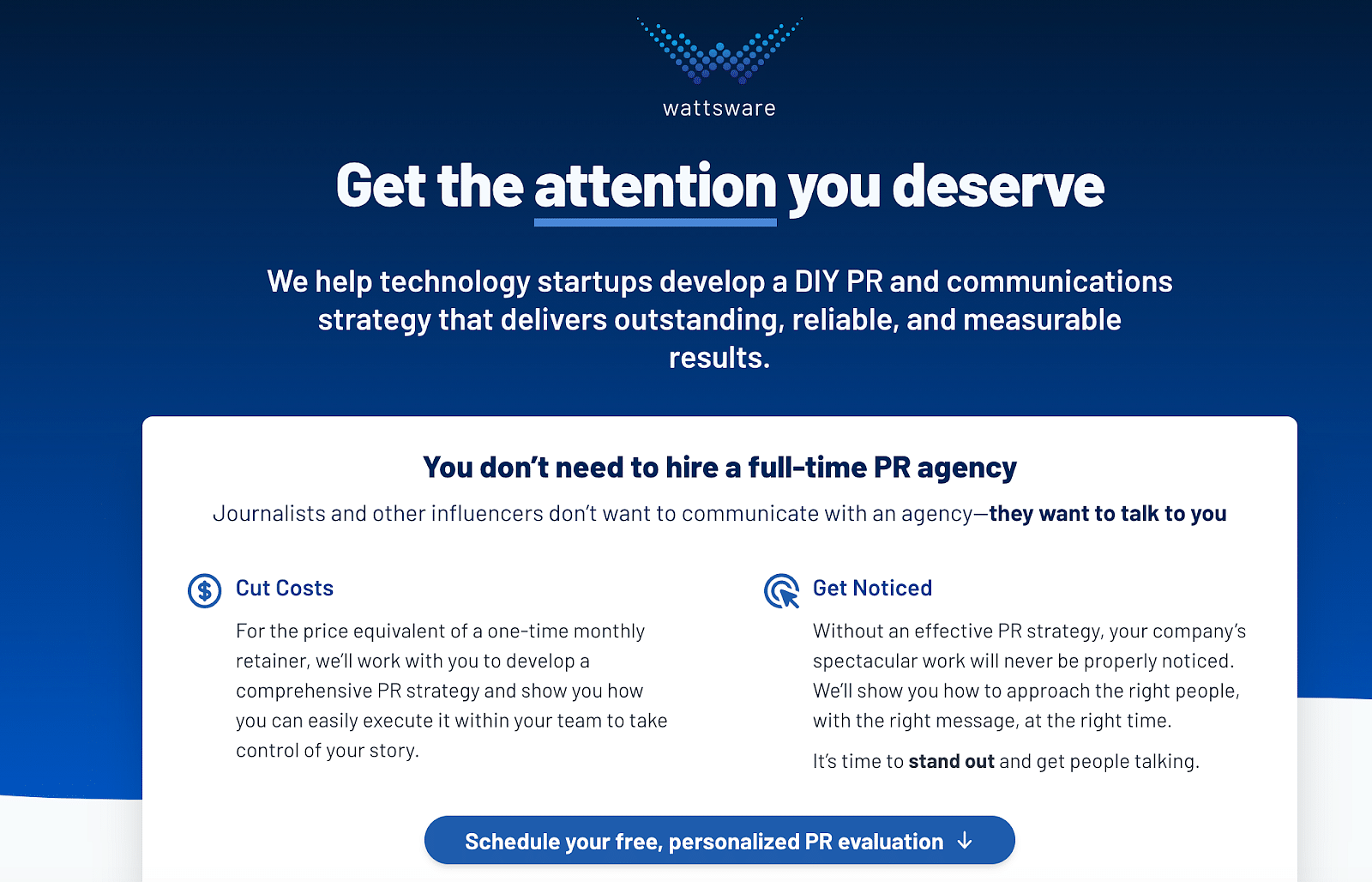
With Brandon Watt’s Five-Stage Methodology, Startups can DIY their Way to PR Success
By Jim James, Founder EASTWEST PR and Host of The UnNoticed Podcast.
Brandon Watts — backed by over 18 years of experience doing public relations — encourages entrepreneurs to handle PR on their own using his five-stage methodology. He is the founder and principal of the PR agency Wattsware, which focuses on helping seed-stage tech startups.
Image from LinkedIn
The Five-Step Methodology
Bradon loves working with early-stage startups as these are companies that are fresh and still trying to figure out who their audience is. Because their budget is still modest, most of them wouldn’t really be interested in working with traditional PR agencies. With Wattsware, he offers do-it-yourself PR strategies to help these companies make their first successful pitch to the press.
His five-step methodology starts with meeting the client to understand their goals. Then he and the client work together to create and review their strategy. After the final strategy is presented, he conducts training on how the client can effectively execute it. After three months, he does a review call to check and assess the progress, see what works and what needs to be tweaked, and offer advice. This methodology, which productises PR service, aims to help small companies do their own PR successfully.
Eliminating the Middleman
Brandon still considers Wattsware a normal PR agency. If there’s a good client that he can help full-time, he will accept that client and assist him or her.
His DIY PR methodology is born out of the separate need that he saw for a certain type of customer, which is the early-stage startup.

Screengrab from Wattsware
If you own a company, you are the best messenger for your product or service. As said on the Wattsware website, reporters and journalists don’t want to talk to an agency — they want to talk to you. Here, PR professionals are considered eliminable middlemen as they bridge two different entities that, in the first place, want to talk to each other.
Through Wattsware, he teaches you how you and your company can handle it yourselves. You can learn the ability to talk to the press — the proper way and at the right time. You can establish a closer connection to them and create your own success because of that direct relationship. Once your company scales up, that’s when you may need to hire a full-time agency.
This approach offers you a way to be lean and be productive through realistic and implementable strategies.
The Efficient Way to Do It
Many companies, including startups, don’t have the time to build and implement their PR strategies.
To efficiently do it, Brandon advises you to start with identifying who your priority contacts are. There are thousands of people you can communicate with through PR activities, so you have to find who has the most impact and best deserves your time and attention.
After identifying them, utilise Twitter. Follow them on the said platform, spend about 15 minutes a day reviewing what they’re saying and what they care about, and interact with them. Being a listener on social media can help you land your pitch better to your target reporters.
Image from Pexels
Another thing that hinders companies from directly getting in touch with the press is the technicality of it. When articulating a message, Brandon advises that less is always more.
After figuring out what your competitors are doing and what is it that makes your company unique, you need to sum it up in a boilerplate. It’s a short paragraph that clearly, comprehensively, and appealingly states what your company is all about. In the book “Building a StoryBrand,” StoryBrand CEO Donald Miller shares principles of storytelling and communication. The storytelling framework that Brandon uses is the problem-solution-experience-results framework.
According to data, 37% of journalists prefer an initial pitch composed of two to three sentences. This debunks the common notion that you have to tell an incredible, long story and incorporate different elements to attract the press. In reality, journalists have time constraints. As they receive hundreds of pitches, you have to make yours interesting as quickly as possible.
Wattsware helps you make your initial contact with the press straightforward, simple, yet attractive. Once you’re able to secure a meeting, a briefing, or a request for an interview, you can now flesh out your story, make it more verbose, and relate it to your goals.
Structuring Content for the Media
Brandon uses a data-focused approach when it comes to structuring content that’s effective for the media. Based on surveys about journalist preferences done by companies such as Muck Rack and Cision, he creates a structure that the press can appreciate. This also covers applying what format do they want and what kind of images appeal to them most.
He also uses such data to improve a company strategy. From that data, he will help you develop quarterly PR strategies, map out the goals you want to achieve along the way, and teach you how you can communicate effectively.
While formatting pitches and communication pieces may be reporter-specific, Brandon advises you to first follow the best practices in the field. After over a year of dealing with reporters, use the feedback that you get to adjust what you’re already doing.
Avoiding Being Internally Focused
Many companies tend to talk about themselves to the point that most of their content becomes internally focused.
Instead of merely doing long blog posts, Brandon encourages you to try out different formats such as video series and podcasts. Citing The UnNoticed Podcast as an example, he shares how it has become effective: It’s not only about advising, but also presenting ways how things are done by actual companies and organisations. Featuring other people and getting other voices also help provide balance.
Image from Pexels
When you as a company always talk about yourself, it can make your audience and the press becomes unresponsive. This is why it’s important to get other people in your industry involved. An interview with an expert, for instance, could be a blog post or a 10-minute video content. This way, you can also foster a mutual relationship with other businesses — you get validation from them while they can promote their own content.
This process involves a lot of creativity and being open-mind to different formats of storytelling that exist today.
Meanwhile, with regards to crisis management (which can be a sensitive topic for many clients), Brandon tries to incorporate it in the process of strategising for his clients. He helps determine possible weak spots and improves them. Crisis management is also about planning for different scenarios and preparing different options or responses to what might occur.
Creating Content Using Different Tools
Different tools can be used to accomplish different things. If you’re trying to create quick visuals for your content, Brandon recommends Canva, which is an easy-to-use online design platform. If you want to develop professional-looking marketing videos, there’s a tool called Biteable. In terms of media monitoring, he relies on SAS tools.
When he works with clients, Brandon tries to cover all the basics so that they won’t need to use different tools. When PR efforts increase, he steps in and instructs them on how to use other tools to make things easier and more efficient. For instance, Newswire can be used for PR distribution.
Giving Voice to Small Startups
Sheryl Sandberg, Facebook’s Chief Operating Officer, previously said that the media aren’t really interested in small companies. For Brandon, however, these businesses have a lot of hope. This is why he likes working with smaller startups. After all, it still boils down to having a good story and the willingness to tell that good story.
Image from Pexels
Many startups today get ambitious when talking to venture capital firms and raising funding. When it’s time to talk to the media, they aren’t quite as ambitious. What Brandon does is help clients realise that they have to tell a big story. It’s about the quality of your work and how you talk about it. Though it will be challenging, PR agencies such as Wattsware can come in to give you advice, find the most appealing angle about your company, and get the attention it deserves.
To kick things off, Brandon recommends focusing on your own media channels first. For instance, plan for quarterly content themes. Then create pitches, share your content on social media, and do some advertisements.
As a fan of Spin Sucks’ Jenny Dietrich, Brandon follows the model that she proposed. The PESO model — which stands for paid, earned, shared, and owned — emphasises that these four media channels should work together for you to get the most mileage for a piece of content. For instance, you can start creating a blog post on your own channel. Then use earned media to pitch it to the press. Then you share it on social media and amplify it with paid advertising.
To know more about Brandon’s DIY PR methodology, visit www.wattsware.com. If you’re an entrepreneur, keep in mind that you yourself can create and manage your own content. And if you need assistance, agencies like Wattsware and EastWest PR are here to provide the services that you need.
This article is based on a transcript from my Podcast The UnNoticed, you can listen here.
Cover photo by Priscilla Du Preez on Unsplash.





